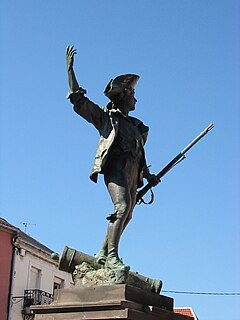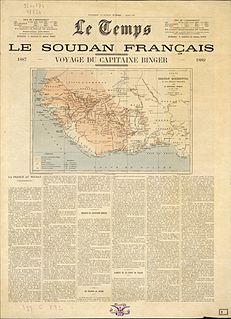 W
WThe Paris Commune was the main insurrectionary commune of France in 1870-1871, based on direct democracy and established in Paris from 18 March to 28 May 1871.
 W
WThe Communards were members and supporters of the short-lived 1871 Paris Commune formed in the wake of the French defeat in the Franco-Prussian War.
 W
WThe Communards’ Wall at the Père Lachaise cemetery is where, on May 28, 1871, one-hundred and forty-seven fédérés, combatants of the Paris Commune, were shot and thrown in an open trench at the foot of the wall.
 W
WThe Declaration to the French People is a summary of the 1871 Paris Commune's political program by its government, the Commune. It was written by three journalists: Charles Delescluze, Jules Valles, and Pierre Denis, a Jacobin, socialist, and Proudhonist, respectively. The Commune adopted the summary three weeks into their term. Only one elected official dissented. The declaration inveighs against the Versailles government and aligns the Commune with other provinces. The program is made in the name of Paris, not the working classes or revolution, and primarily demands a republican government and secondly, Commune autonomy extended to all of France, giving local bodies control over administration, economics, education, and security. It referenced a federation between communes.
 W
WThe term "fédérés" most commonly refers to the troops who volunteered for the French National Guard in the summer of 1792 during the French Revolution. The fédérés of 1792 effected a transformation of the Guard from a constitutional monarchist force into a republican revolutionary force.
 W
WLéon Gambetta was a French lawyer and republican politician who proclaimed and played a prominent role in the French Third Republic.
 W
WThe Government of National Defense was the first government of the Third Republic of France from 4 September 1870 to 13 February 1871 during the Franco-Prussian War. It was formed after the proclamation of the Republic in Paris on 4 September, which in turn followed the surrender and capture of Emperor Napoleon III by the Prussians in the Battle of Sedan. The government, headed by General Louis Jules Trochu, was under Prussian siege in Paris. Breakouts were attempted twice, but met with disaster and rising dissatisfaction of the public. In late January the government, having further enraged the population of Paris by crushing a revolutionary uprising, surrendered to the Prussians. Two weeks later, it was replaced by the new government of Adolphe Thiers, which soon passed a variety of financial laws in an attempt to pay reparations and thus oblige the Prussians to leave France, leading to the outbreak of revolutions in French cities, and the ultimate creation of the Paris Commune.
 W
WMarie Edme Patrice Maurice de MacMahon, marquis de MacMahon, duc de Magenta was a French general and politician, with the distinction of Marshal of France. He served as Chief of State of France from 1873 to 1875 and as President of France, from 1875 to 1879.
 W
WThe Massacre in the Rue Haxo was a massacre of Christians perpetrated by the Communards from the Paris Commune during the bloody Semaine Sanglante of May 1871.
 W
WThe National Guard is a French military, gendarmerie, and police reserve force, active in its current form since 2016 but originally founded in 1789 during the French Revolution.
 W
WOlivier Pain was a French journalist and Communard notable for his escape from New Caledonia alongside Henri Rochefort, and for travelling to the Sudan during the Mahdist War. He also wrote under the pseudonym Olivier Tolcès.
 W
WThe penal colony of New Caledonia was a penitentiary establishment which was in operation from 1864 to 1924. Many French prisoners from mainland France were deported there.
 W
WLe Père Duchêne is the title of a newspaper which appeared during revolutionary periods of the nineteenth century. It borrowed its title from the original Père Duchesne published by Jacques Hébert during the French Revolution. After Hébert's death, the title reappeared with all sorts of variations from the 1790s on, notably during the Revolution of 1848 and the Paris Commune of 1871.
 W
WPétroleuses were, according to popular rumours at the time, female supporters of the Paris Commune, accused of burning down much of Paris during the last days of the Commune in May 1871. During May, when Paris was being recaptured by loyalist Versaillais troops, rumours circulated that lower-class women were committing arson against private property and public buildings, using bottles full of petroleum or paraffin which they threw into cellar windows, in a deliberate act of spite against the government. Many Parisian buildings, including the Hôtel de Ville, the Tuileries Palace, the Palais de Justice and many other government buildings were in fact set afire by the soldiers of the Commune during the last days of the Commune, prompting the press and Parisian public opinion to blame the pétroleuses.
 W
WEugène Protot, born in the French town Carisey in the province of Yonne, on 27 January 1839 and died in Paris 17 February 1921 was a political figure during the Paris Commune.
 W
WVictor Henri Rochefort, Marquis de Rochefort-Luçay was a French writer of vaudevilles and politician. He was born in Paris and died in Aix-les-Bains.
 W
WThe siege of Paris took place from 19 September 1870 to 28 January 1871 and ended in the consequent capture of the city by Prussian forces, culminating in France's defeat in the Franco-Prussian War and the establishment of both the German Empire and the Paris Commune.
 W
WThe Tage ("Tagus") was a 100-gun Hercule-class ship of the line of the French Navy.
 W
WLe Temps was one of Paris's most important daily newspapers from 25 April 1861 to 30 November 1942. It was a serious paper of record.
 W
WPaul-Marie Verlaine was a French poet associated with the Symbolist movement and the Decadent movement. He is considered one of the greatest representatives of the fin de siècle in international and French poetry.